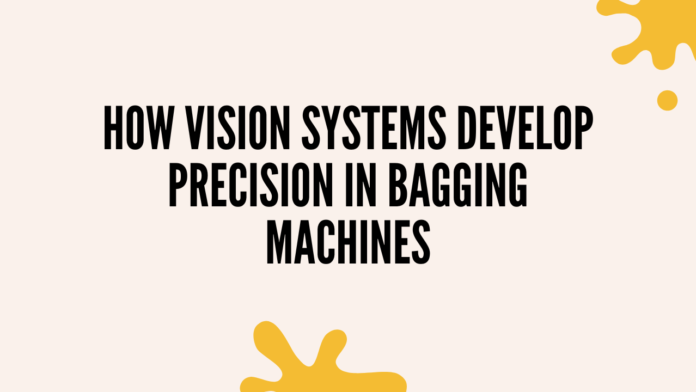In the speedy universe of packaging and assembling, accuracy is principal. Whether it’s food items, drugs, or consumer goods, the accuracy of bundling cycles can straightforwardly influence item quality, consumer loyalty, and functional effectiveness. For ventures depending on bagging machines to package items, keeping up with precision can be a test, particularly while managing high volumes of things. This step is where vision systems become an integral factor.
Vision systems, which use cameras and sensors to catch itemized pictures and information, have reformed how bagging machines work. They offer a degree of accuracy and mechanization that manual checks can’t coordinate. In this blog, we’ll investigate how vision systems upgrade the exactness of bagging machines, decrease blunders, and, at last, lead to improved efficiency and item quality.
- Guaranteeing Right Product Fill Levels
One of the critical difficulties in bagging is guaranteeing that each pack contains the perfect proportion of items. Whether it’s a sack of chips, grains, or synthetic substances, filling machines need to administer the right amount every time. To an extreme or too few items can prompt squandered materials, disappointed clients, or administrative consistency issues.
Vision systems assist with taking care of this issue by outwardly checking how many items are in each pack. High-goal cameras can be situated over the bagging line to check, assuming that the fill level matches the objective amount. Assuming the fill is too high or too low, the vision system can quickly set off the machine to change or even oddball the inappropriately filled bag.
Why It Is Important:
By guaranteeing each bag is filled accurately, vision systems lessen material waste and stay away from the expense of revising bags. Also, they assist with keeping up with reliable product quality, which is vital for both consumer loyalty and keeping up with administrative norms.
- Precise Sealing and Labelling
After the item is filled into the bags, appropriate fixing and naming are basic for item uprightness and detectability. Bagging machines should guarantee that each pack is appropriately fixed to forestall spillage or tainting during stockpiling and travel. Furthermore, exact marking, including expiry dates, bunch numbers, and fixings, is fundamental for consistency and client data.
Vision systems incorporated with bagging machines can check both the seal and the name. They use cameras to check, assuming the pack’s seal is unblemished and adjusted accurately, guaranteeing that no air or dampness can think twice about the item. For labelling, vision systems can peruse and affirm whether the right mark has been applied to each pack. This step is particularly significant while managing high volumes or different product offerings, where manual checks could miss blunders.
Why It Is Important:
This degree of accuracy limits the risk of items being sent with incorrect seals or marks, which could bring about well-being issues, item reviews, or lawful repercussions. Via computerizing the review cycle, vision systems guarantee that each sack satisfies the organization’s guidelines for quality and consistency.
- Ongoing Mistake Identification and Adjustment
One of the most impressive advantages of vision systems is their capacity to identify blunders progressively. In customary bagging lines, blunders —for example, under-filled bags, broken seals, or skewed names — probably won’t be gotten until after the bags are packed and shipped off capacity. At that point, adjusting the issue without causing additional costs is past the point of no return.
With vision systems set up, blunders are distinguished in a flash as items drop down the line. The framework can promptly make the administrator or even make programmed changes aware of the bagging machine with practically no human mediation. For example, on the off chance that a bag is skewed or the fill weight is off, the vision system can set off the machine to stop, reject the defective bag, or change the settings to guarantee the following bag is filled accurately.
Why It Is Important:
This ongoing rectification dispenses with expensive mix-ups and keeps the creation line moving along as expected. By making mistakes early, the requirement for manual modification is decreased, and the general effectiveness of the creation cycle is enormously gotten to the next level.
- Limiting Product Waste
Product waste is a main issue for any producer, particularly those working with costly unrefined substances. Off-base filling, bundling surrenders, or inappropriately fixed bags can prompt a lot of waste, costing cash and hurting the climate. Vision systems assume a key part in limiting this loss by guaranteeing that each step of the bagging system is executed with the most noteworthy precision.
For instance, in the event that the vision system recognizes an under-filled bag, it can quickly eliminate the faulty bag from the creation line, keeping it from going further into the packaging system. Also, the framework can guarantee that the appropriate fill weight is kept up reliably across all sacks, abstaining from stuffing or over-the-top utilization of materials.
Why It Makes a Difference:
By limiting waste, vision systems add to both expense investment funds and manageability. Makers can advance their utilization of materials, diminishing the abundance of packaging and eliminating natural effects, all while keeping up with great principles.
Conclusion: Accuracy and Productivity Combined
Vision systems are changing the manner in which bagging machines work, bringing exceptional degrees of precision, speed, and quality control to the bundling system. By guaranteeing the right item fill levels, checking seals and tags, distinguishing mistakes progressively, and limiting waste, vision systems contribute altogether to both functional effectiveness and product consistency.
For manufacturers hoping to develop their bagging processes, incorporating vision systems is a brilliant speculation. These systems lessen blunders and waste and assist with keeping up with exclusive requirements of value that purchasers anticipate. In the present serious commercial centre, that degree of accuracy is, as of now, not simply an extravagance — it’s a need.
